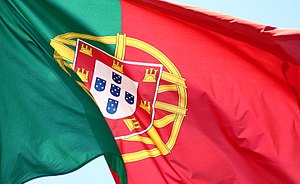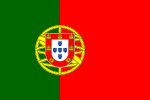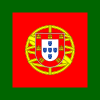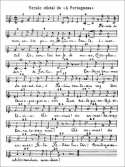
Luís Vaz de Camões, sometimes rendered in English as Camoens or Camoëns, is considered Portugal's and the Portuguese language's greatest poet. His mastery of verse has been compared to that of Shakespeare, Milton, Vondel, Homer, Virgil and Dante. He wrote a considerable amount of lyrical poetry and drama but is best remembered for his epic work Os Lusíadas. His collection of poetry The Parnasum of Luís de Camões was lost during his life. The influence of his masterpiece Os Lusíadas is so profound that Portuguese is sometimes called the "language of Camões".

"A Portuguesa" is the national anthem of Portugal. The song was composed by Alfredo Keil and written by Henrique Lopes de Mendonça during the resurgent nationalist movement ignited by the 1890 British Ultimatum to Portugal concerning its African colonies. Used as the marching song of the failed republican rebellion of January 1891, in Porto, it was adopted as the national anthem of the newborn Portuguese Republic in 1911, replacing "Hino da Carta", the anthem of the deposed constitutional monarchy.

The culture of Portugal is a very rich result of a complex flow of many different civilizations during the past millennia. From prehistoric cultures, to its Pre-Roman civilizations, passing through its contacts with the Phoenician-Carthaginian world, the Roman period, the Germanic invasions of the Suebi, Buri and Visigoths, Viking incursions, Sephardic Jewish settlement, and finally, the Moorish Umayyad invasion of Hispania and the subsequent expulsion, during the Reconquista, all have made an imprint on the country's culture and history.

Eugénio de Paula Tavares was a Cape Verdean poet. He is known through his famous poems (mornas), mostly written in the Creole of Brava.

Joaquim de Magalhães Fernandes Barreiros, known professionally as Quim Barreiros, is a Portuguese Pimba music writer,singer and accordion player, more known for his double entendre songs. Among his biggest hits are Bacalhau à Portuguesa [Portuguese Style Cod] (1986), A Garagem da Vizinha [The Neighbour's Garage] (2000) and A Cabritinha [The Little Goat] (2004).

Vasco Navarro da Graça Moura, GCSE GCIH OSE was a Portuguese lawyer, writer, translator and politician, son of Francisco José da Graça Moura and wife Maria Teresa Amado da Cunha Seixas Navarro de Castro, of Northern Portugal bourgeoisie.

The Military Order of Christ is the former order of Knights Templar as it was reconstituted in Portugal. Before 1910, it was known as the Royal Military Order of Our Lord Jesus Christ, and the Order of the Knights of Our Lord Jesus Christ. It was founded in 1319, with the protection of King Denis of Portugal, after the Templars were abolished on 22 March 1312 by the papal bull, Vox in excelso, issued by Pope Clement V. King Denis refused to pursue and persecute the former knights as had occurred in most of the other sovereign states under the political influence of the Catholic Church.

Belém is a freguesia and district of Lisbon, the capital of Portugal. Belém is located in western Lisbon, to the west of Ajuda and Alcântara and directly east of Lisbon's border with Oeiras. Belém is famous as a museum district, as the home of many of the most notable monuments of Lisbon and Portugal alike, such as the Belém Tower, the Jerónimos Monastery, the Padrão dos Descobrimentos, and Belém Palace. The population in 2011 was 16,528.

Marcelo Nuno Duarte Rebelo de Sousa is a Portuguese politician and academic. He is the 20th and current president of Portugal, since 9 March 2016. He is a member of the Social Democratic Party, though he suspended his party membership for the duration of his presidency. Rebelo de Sousa has previously served as a government minister, parliamentarian in the Assembly of the Portuguese Republic, legal scholar, journalist, political analyst, law professor, and pundit.

José Leitão de Barros was a Portuguese film director and playwright.

The Instituto Camões, formally, Camões — Instituto da Cooperação e da Língua, I. P., is a Portuguese international institution dedicated to the worldwide promotion of the Portuguese language, Portuguese culture, and international aid, on behalf of the Government of Portugal. Headquartered in Lisbon with centers across five continents, the mission of the Instituto Camões is the promotion of Portugal's language, culture, values, charity, and economy. The institution is named for Portuguese Renaissance author Luís Vaz de Camões, considered the greatest poet of the Portuguese language and the national poet of Portugal.

The 5 October 1910 revolution was the overthrow of the centuries-old Portuguese monarchy and its replacement by the First Portuguese Republic. It was the result of a coup d'état organized by the Portuguese Republican Party.

João Edmundo Lemos Carqueijeiro is a Portuguese plastic artist. He was born in Lobito, Angola on 25 February 1954.

Concerto em Lisboa is a live album released by fado singer Mariza on November 6, 2006. It was nominated in 2007 for a Latin Grammy in the category of Best Folk Album, becoming the first Portuguese artist to receive a nomination for a Latin Grammy Award.

The "Hymn of the Azores" is the official regional anthem used during some ceremonies in the Portuguese autonomous region of the Azores. For official purposes, the national anthem, "A Portuguesa", is always used during government events, in sporting venues, and during other civic ceremonies.

The Secondary School Luís de Camões is a secondary school located in the civil parish of Arroios, in the municipality and Portuguese capital of Lisbon, classified as a Monumento de Interesse Público in 2012.
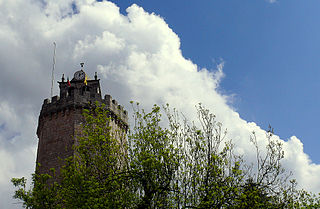
The Castle of Freixo de Espada à Cinta is located in the civil parish of Freixo de Espada à Cinta e Mazouco, municipality of Freixo de Espada à Cinta, in the Portuguese district of Bragança.
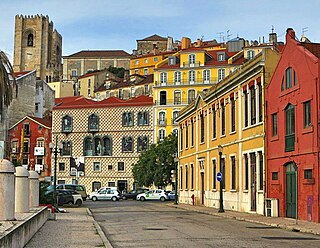
Lisbon is one of the most popular city destinations in Europe. The city of Lisbon and the Lisbon metropolitan area attracts a significant number of tourists each year, drawn to its historical and cultural heritage, good transportation connections and good touristic infrastructure.

The Royal Portuguese Cabinet of Reading is a library and lusophone cultural institution, is located in Luís de Camões Street, number 30, in the center of the city of Rio de Janeiro, Brazil. It is listed by the State Institute of Cultural Heritage. Elected the fourth most beautiful library in the world by Time magazine, the Cabinet has the largest collection of Portuguese literature outside Portugal.
